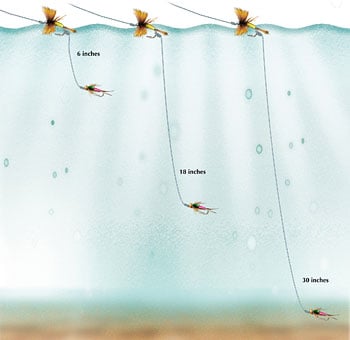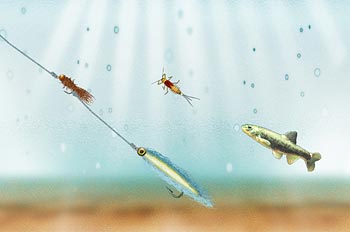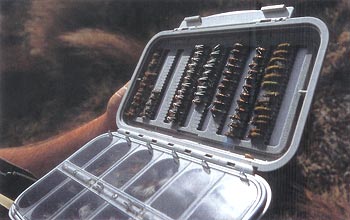“Seeing Double”

The length of a nymph dropper should be determined by where the fish are feeding in the water column. If trout are taking nymphs right below the surface, a 6-inch dropper will put the fly in the right zone. Earlier in the hatch, before there are many duns on the water, an 18-inch dropper may take more fish. If you want the fly right near the bottom, a 30-inch dropper will do the trick in shallow water.
A Tangled Subject
ALTHOUGH MULTI-FLY RIGS have been around for centuries and have always remained popular in Europe, fishing more than one pattern was nearly a forgotten science in this country until about 15 years ago. In fact, even when angling magazines flooded the market with tandem-rig stories, many anglers outside the Rockies took a long time to catch on. For instance, my older brother, Brian, has been fly fishing since the late 1970s, but he had never fished two flies until we traveled to Wyoming last summer. Troll a few Internet message boards, and you’ll find that a large portion of the fly-fishing community is still discovering the effectiveness of this “modern” technique.
But there’s a big difference between simply hanging a Copper John off the back of a grasshopper pattern (a rig commonly known as the “Hopper-Dropper”) and incorporating two-fly systems into your everyday angling arsenal. Many anglers think of the second fly as nothing more than an add-on, not as an integral part of their tactical approach, and they treat tandem rigging as a one-size-fits-all subject. Oftentimes, speakers or writers will refer to a “standard” tandem rig that features a nymph tied to a 12-inch (or 18-inch, or 24-inch, and so on) dropper. But such a “standard” fails to take into account water depth, current speed, weight of the nymph, and all the other myriad variables you’ll face on the stream. To exploit the full potential of two-fly rigs, you’ve got to put the same amount of thought into the components, construction, and performance of your rig as you put into matching the hatch.

The combination of a heavy beadhead and a more buoyant nymph can be deadly. Dead-drifted, this rig puts the larger fly on the bottom, while the bottom fly imitates an insect that has been knocked into the drift. If you twitch your rod tip, you can make the bottom nymph dive and rise again, which often triggers a strike.
The Clincher
The first hurdle an angler has to get over is fear of knots. I came late to two-fly rigs because I couldn’t see myself tying blood knots with extra-long tag ends, which were required for the old-style dropper systems I saw illustrated in my grandfather’s books. (To be fair, I look at those same diagrams now and wonder what intimidated me about them.) But the first time I saw someone clinch-knot the dropper to the bend of the top fly — it was a fellow guide on Depuy’s spring creek — I mentally slapped myself silly for not having discovered such a simple solution on my own.
There are still plenty of fly fishermen who tie blood-knot dropper rigs, and I know guys who swear that this method will always outfish an in-line, clinch-knotted system. I smile and nod when they explain their reasoning, but I’ve never seen any evidence to support the assertion. For instance, guides make their living by catching fish, and I’ve never seen a pro tie any kind of tandem rig other than in-line. Sure that’s an unscientific sampling, but it’s good enough for me. The in-line rig is easier to tie, easier to cast, and tangles less.

A tandem rig featuring a nymph on top and a streamer on the bottom imitates a baitfish feeding on emerging nymphs. Oftentimes, a large trout that isn’t interested in the nymph will take the opportunity to whack the baitfish imitation.
You can make the knot-tying processes easier in several ways. Some find that the loop at the bottom of the clinch knot tends to slide off the hook just as they try to thread the tag end through. By simply holding the top fly upside down (e.g., hook up), you can solve this problem.
Several years ago, a Green River guide showed me a slick way to tie the clinch knot in the leader material first and then slide the loop onto the hook. (See instructions on tying an Easy Dropper Loop at the bottom of this article.) If you’re familiar with the water you’ll be fishing — and therefore understand what kinds of tandem rigs you’ll need — you can tie the two flies together at home and carry the complete rigs rolled up in old film canisters (for a dry and a nymph) or leader envelopes (for two nymphs). Then all you’ve got to do is tie on the top fly, and you’re in business.
Matched Pairs
There is no limit to the number of useful two-fly combinations you can use: two drys, a dry and an emerger, a dry and a nymph, two nymphs, two streamers, a streamer and a nymph, and on and on. Although I’ve never tried it, I can even think of a couple of situations in which you’d want to fish a dry fly with a streamer as a dropper (or even vice versa). The topic of fly choice is too massive for a single article, so we won’t delve much into specific pairings; obviously, you want to use patterns that imitate the insects or baitfish that are available to trout. (See “Useful Tandem Fly Combinations” for a few choice alternatives.)

The perfect summertime tandem-rig fly box features plenty of big attractor drys and various nymph patterns of different weights. With this fly selection, you can cover a lot of water. Sandy Hays photo
But before you tie on any two flies, take a few moments to ask yourself a fundamental but too often overlooked question:What am I trying to do with this rig? As fly fishermen, we do a lot things out of habit or tradition. Other times, the course of action is so obvious that it requires little examination — when you can see trout slurping down duns, you tie on your closest imitation of what’s on the water. But when it’s not so clear what the trout are eating, most of us would be better off if we spent more time assessing the situation and thinking through our approach before we started casting. This is especially true when you’re using two flies, because the ways that the flies interact with each other becomes vitally important to the presentation.
The large question above can be broken down into two parts: (1) How are the fish feeding? and (2) How can I construct a two-fly rig that will exploit this feeding behavior? The answer to question 1 is usually just a guess (hopefully an educated one), but you are in complete control of question 2.
For instance, if a hatch is in full swing but the fish aren’t taking the duns, you know that you should tie on a nymph as a dropper to imitate the emerging naturals. That’s just common sense. But how long should the dropper be? Before you attach that second fly, you need to determine the particular stage of the hatch and observe the behavior of the fish.
If there are just a few duns on the water and you don’t yet see feeding fish near the surface, a nymph on a 24-inch dropper will almost always catch more fish than a nymph on a 6-inch dropper because the trout are looking for nymphs lower in the water column. But, if trout are porpoising just below the surface, that shorter dropper line could be just the ticket because it puts the fly right where the fish expect to see it. Depending on how deep and fast the water is, you might need a 30-inch dropper to imitate the nymphs swimming up from the stream bed in the moments just before the duns start popping up on the surface. Clearly, an angler who indiscriminately chooses a 12- or 18-inch dropper every time out is not giving himself the best chances to score.
You must also think about how the flies will behave in the water. When you’ve got two nymphs on, for instance, the drift of each will be affected by the other, and you can use this to your advantage. If you see trout in fast, clear water feeding on small mayfly nymphs near the bottom, you’ve got a difficult presentation problem. You need to get a small Pheasant Tail down fast, yet make it look as if it’s drifting free.

An Easy Dropper Loop Some people have difficulty making the clinch knot on the hook bend. The line has a tendency to slip off, especially if the hook is barbless, and sometimes the hackle or tail gets in the way. Gene Gautieri, a guide on Utah’s Green River, showed me a neat trick to avoid these problems — tying the clinch knot in the tippet material before you attach it to the hook bend. 1. Start by making a small loop in one end of the tippet material, and put two fingers inside the loop. (I’ve used fly line here for better visibility.) 2. Next, twist the loop six times. 3. With the tag end, go through the loop and then back through the second loop created by the tag end and the standing line. 4. Snug up the knot, and you’ve got a clinch knot with a loop that will slip. Put the loop around the hook bend, and tighten it up. Voila! Michelle Boisse photo
Tie on a bead-head nymph as the top fly, and then determine the length of the dropper tippet by asking how far off the bottom you’d like the second, lighter fly to be. The heavy bead-head will drag the lighter fly down in the water column, but a long dropper will allow the Pheasant Tail to drift above the stream bed and be buffeted by small changes in the current, just like the real thing. A shorter dropper will keep the second fly closer to the bottom.
A good friend and serious angler likes to use the combination of a bead-head stonefly imitation and a buoyant mayfly pattern. He reasons that “swimmer” nymphs, such as blue-winged olives andIsonychia, that get knocked into the drift will wriggle their way back to the bottom as fast as they can and trout must be conditioned to eat these nymphs before they can reach safety. The bead-head fly gets the rig down to the bottom, and the buoyant fly drifts above it. By twitching the rod tip, my friend makes the second fly dive toward the bottom like a panicked natural. This is a great setup to use in a slow pool below a riffle.
This is the perfect example of an angler who has carefully considered how best to make his two-fly rig imitate a specific behavior that will elicit strikes. For many of us, what makes fly fishing so much more interesting than other forms of angling is that it requires us to think through the various processes — rigging, casting, drifting, and the like — required to catch fish. Building and using tandem rigs should be based on that same process of inquiry and problem solving.
If you’ve never tried fishing a tandem rig, give it a shot; there’s nothing very complicated about the setup, and it will increase your chances of hooking up. If you already fish two flies, you can make the game more interesting and productive by tailoring each tandem rig to the specific conditions you find on the water. Do away with the notion of a “standard” rig, and use your ability to read water and your knowledge of trout behavior to fashion a two-fly system that will give you the best chance to hook up.











